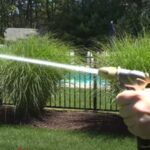If your lawn feels more like a tangled mess than a smooth green carpet, it might be time to consider dethatching. You want your grass to breathe, soak up nutrients, and grow strong, but thick layers of thatch can hold it back.
So, what is the best dethatcher for your yard? Choosing the right tool can make all the difference between a healthy lawn and one that struggles. You’ll discover the top dethatchers that fit your needs and budget, plus tips on when and how to use them for the best results.
Keep reading to find the perfect match for your lawn care routine!
You May Like
- High-Powered Performance: Equipped with a 12-amp motor, this versatile…
- Customizable Depth Control: Adjust the 5-position height settings to tailor…
- Enhanced Aeration for Lush Growth: The scarifier function cuts into grass…
- Air Boost Technology for Maximum Pickup: Durable spring steel tines…
- [Powerful Electric Motor]:Equipped with a copper motor, this electric…
- [15-Inch Rake Path with Adjustable Depth]:With a 15-inch wide rake path and…
- [Quick-Switch 2-in-1 Blades]:Use the dethatcher to clear thatch and moss or…
- [Large 45L Collection Bag for Efficient Lawn Maintenance]:A large 45L…
- High-Performance Machine: Equipped with a powerful 13-amp motor that…
- Large Collection Bag: The spacious and removable collection bag makes it…
- Customizable Depth Control: Tailor the dethatching and scarifying depth to…
- Smooth and Effortless Maneuverability: Designed with four durable,…
- WORKING DEPTH AND HEIGHT ADJUSTMENT: Adjust the 5-position control lever to…
- 2-IN-1 QUICK-RELEASE BLADE: The TIECTOWN lawn dethatcher features both…
- LIGHTWEIGHT AND EASY TO STORE: Weighing just 30 lbs, this dethatcher is…
- POWERFUL 15A MOTOR (Peak 15.5A): This dethatcher/scarifier is equipped with…
- [Powerful 13 Amp Electric Motor]:Equipped with a 13 Amp copper motor, this…
- [13-Inch Rake Path with Adjustable Depth]:With a 13-inch wide rake path and…
- [Quick-Switch 2-in-1 Blades]:Use the dethatcher to clear thatch and moss or…
- [Large 30L Collection Bag for Efficient Lawn Maintenance]:A large 30L…
Types Of Dethatchers
Electric dethatchers are light and easy to use. They work well for small to medium lawns and need less maintenance. Gas dethatchers are stronger and better for large areas but can be noisy and need fuel.
Manual dethatchers are simple tools that require physical effort. They are cheap and eco-friendly but take more time. Tow-behind dethatchers attach to lawn tractors, making dethatching faster on big lawns.
| Type | Best For | Pros | Cons |
|---|---|---|---|
| Electric | Small to medium lawns | Lightweight, low maintenance | Less powerful, cord limits range |
| Gas | Large lawns | Powerful, cordless | Noisy, needs fuel and upkeep |
| Manual | Small lawns or spots | Cheap, eco-friendly | Labor-intensive, slow |
| Tow-Behind | Very large lawns | Fast, covers big area | Needs tractor or mower |
| Front-Mount Attachments | Lawn tractors | Easy to use, efficient | Expensive, needs compatible tractor |
When To Dethatch
Best seasons depend on grass type. Cool-season grasses thrive in early spring or fall. Warm-season grasses do well in late spring or early summer. Dethatching during these times helps grass recover quickly and grow strong.
Soil moisture is key. Soil should be moist but not soggy. Dry soil makes dethatching hard and can damage roots. Wet soil can cause compaction and harm lawn health.
- Thick thatch layer: More than 1/2 inch of thatch blocks water and nutrients.
- Poor grass growth: Lawn looks thin or patchy.
- Water puddles: Water stays on surface, not soaking in.
- Spongy feel: Lawn feels soft when stepped on.
Watch for these signs to know when to dethatch. Regular checks keep your lawn healthy and green.
Benefits Of Dethatching
Dethatching helps grass absorb water and nutrients better. It removes thick layers of dead grass and debris. This lets moisture reach the soil easily. Roots can then grow strong and healthy.
Seeds have a better chance to sprout after dethatching. The soil surface becomes less crowded. This helps new grass grow quickly and evenly. More seeds can take root and thrive.
The lawn looks fuller and healthier after dethatching. Dead material is gone, so green grass shows more. The lawn feels soft and thick underfoot. It also stays green longer in dry times.
When To Skip Dethatching
New lawns and seedlings need gentle care. Dethatching can harm young grass roots. It is best to wait until the lawn is well established before dethatching. Thin thatch layers do not block water and nutrients. Dethatching thin layers can damage healthy grass and is often unnecessary.
Stress periods like drought or extreme heat make lawns weak. Dethatching during these times can increase stress and damage the grass. Dormant lawns do not grow, so dethatching then slows recovery. The best time to dethatch is when grass is actively growing and healthy.
Top Dethatcher Picks
Budget-friendly dethatchers offer good value for small lawns. They are light and easy to use. Models like Lowe’s $129.99 and Tractor Supply’s $109.99 dethatchers work well for occasional use. These are perfect for homeowners who want to improve lawn health without spending much.
High-end options provide more power and durability. They suit larger lawns or frequent use. Brands such as Ryobi $429.00 and Shields Reels $319.99 have strong motors and wider tines. These machines clear thick thatch quickly and last longer.
| Type | Price Range | Features |
|---|---|---|
| Budget-Friendly | $100 – $160 | Lightweight, easy to use, suitable for small lawns |
| High-End Performance | $300 – $430 | Powerful, durable, wider coverage, ideal for large lawns |
| Electric with Scarifiers | $140 – $170 | Electric powered, combines dethatching and scarifying |
Electric dethatchers with scarifiers are good for lawn care in one step. They remove thatch and loosen soil. Models found at Home Depot around $144 are popular. These tools need moist soil to work best, not too wet or dry.
Key Features To Consider
Collection bags help gather debris, making cleanup faster and easier. Some dethatchers come without bags, requiring manual cleanup.
Adjustable depth and width settings allow you to customize the dethatching process. This helps prevent damage to your lawn and suits different grass types.
Power and durability are important for efficient dethatching. Strong motors and sturdy build ensure the machine works well over time and in tough conditions.
Maintenance Tips
After using a dethatcher, clean the blades and tines carefully. Remove all grass, dirt, and debris to keep it working well. Use a brush or cloth to wipe down the parts. Avoid leaving wet grass, which can cause rust.
Store the dethatcher in a dry, cool place. Keep it away from moisture and direct sunlight. This helps protect the metal parts and extends the tool’s life. Cover it with a cloth or plastic cover if possible.
Check the blades regularly for wear or damage. Replace any dull or broken blades to keep dethatching effective. Sharpen blades when they become blunt, but do so carefully to avoid injury. A sharp blade makes the job easier and safer.
Dethatching Techniques
Start by mowing the lawn shorter than usual. This helps the dethatcher reach the thatch layer easily. Next, water the lawn a day before dethatching. Soil should be moist but not wet. Avoid dethatching during hot or dry days to prevent stress on grass.
Use a dethatcher machine or rake to remove dead grass and debris. Move slowly and cover the entire lawn in overlapping rows. Collect the loosened thatch with a rake or lawn vacuum for a clean finish.
After dethatching, water the lawn well to help recovery. Apply a thin layer of fertilizer to boost new growth. Avoid heavy foot traffic for a few days to protect the grass. Regular mowing and watering will keep the lawn healthy.

Credit: www.popularmechanics.com
Frequently Asked Questions
What Type Of Dethatcher Is Best?
The best dethatcher depends on your lawn size and type. Electric dethatchers suit small lawns; gas-powered work well for large areas. Choose one with adjustable tines for effective thatch removal and easy depth control.
Is It Worth It To Buy A Dethatcher?
Buying a dethatcher is worth it if your lawn has thick thatch, poor water absorption, or needs overseeding. It improves lawn health and appearance.
What Is The Best Time Of Year To Dethatch A Lawn?
The best time to dethatch a lawn is early spring or late fall. Dethatch just before new growth begins, avoiding hot or wet soil.
What Are Common Dethatching Mistakes?
Common dethatching mistakes include dethatching too often, using the wrong equipment, working on wet or dry soil, and dethatching in extreme weather. Avoid damaging grass by setting the dethatcher too deep or neglecting lawn recovery after dethatching.
Conclusion
Choosing the best dethatcher depends on your lawn’s needs and budget. Electric dethatchers suit small yards well. Gas models work better for bigger areas. Always check the features before buying. Use your dethatcher in early spring or late fall. This helps your lawn grow healthy and green.
Regular dethatching improves soil air and water flow. Keep your lawn neat and ready for new growth. A good dethatcher makes lawn care easier and more effective.









